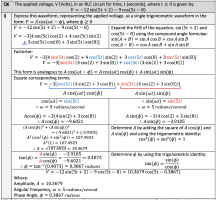freckles101
New member
- Joined
- May 10, 2022
- Messages
- 7
Express f(t) in the form: Acos(ωt-ϕ)
f(t)=-12 sin(5t+2)-9 cos(5t-8)
f(t)=-12 sin(5t+2)-9 cos(5t-8)
Expand using the Compound Angle formulae and gather like terms,Express f(t) in the form: Acos(ωt-ϕ)
f(t)=-12 sin(5t+2)-9 cos(5t-8)
That's great adviceExpand using the Compound Angle formulae and gather like terms,
then convert to Wave Function.
Continue....
I'd keep the answer exact by declaring two constants c1=−(?sin(?)+?cos(?)) and c2= something similarNB:[/B] Just state your work is to 2 (or 3) decimal places to permit the use of =instead of≈
Whilst mathematically 'sound', I find introducing more 'letters' can cause confusion (they can start to look like more variables/unknowns to be dealt with) and pupils find it easier to both understand & manipulate when they are dealing with actual numbers.That's great advice
I'd keep the answer exact by declaring two constants c1=−(?sin(?)+?cos(?)) and c2= something similar
Glad we were able to help. ?Thank you so much @The Highlander and @Cubist , really appreciative for your pointers. I feel like i can answer this one now!! It was just an unfamiliar form and i freaked out a bit! haha
Hi freckles,thank you so much!! please excuse my messy writing! but does this look okay?

Haha yeah, I rushed through that one, and have noticed a few algebraic mistakes... I've since typed it out with the corrections i saw that were required... does this look closer to the answer you got? Thank you so much for your support and assistance!!Hi freckles,
I'm afraid that's not what I get. ?
Let me check through your working and I'll try to explain where you've gone wrong.

No, I’m sorry but that’s still not right.Haha yeah, I rushed through that one, and have noticed a few algebraic mistakes... I've since typed it out with the corrections i saw that were required... does this look closer to the answer you got? Thank you so much for your support and assistance!!
View attachment 32753
